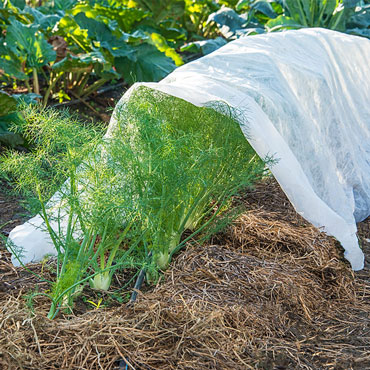Techniques for Extending the Growing Season: Floating Row Covers
This series offers some common techniques that you can use to try to extend your growing season. Most of the methods help your soil stay warmer and protect your plants from harsh, cold winds. These techniques can be adopted one at a time, or you can use more than one simultaneously to try to achieve more success. When these practices are added on to others, they can have an even more protective effect. Keep reading for tips related to floating row covers.

Floating row covers are also known as garden fabric. This fabric can come in two weights: lightweight and heavyweight. If you want an affordable and simple way to protect plants from warm or cold spells or frost, these are a great way to go.
One of the best things about floating row covers is the flexibility they offer gardeners. Unlike greenhouses and hoophouses, they allow air flow and water to circulate through, so less maintenance is needed to ensure they get vented when temperatures are higher. In the spring, you can use row covers to harden off spring transplants or start them growing early. In the fall, you can eke out a couple more weeks of the growing season with less frost-tolerant plants and even use heavyweight row covers all winter to grow frost-tolerant vegetables, especially in areas with milder winters. For more protection, you can place a second layer of fabric over the first, but you don’t want to use more than two layers since this will decrease the amount of sunlight that gets to the plants underneath.
Some things to consider when you are using row covers to protect plants:
- You will definitely want to check for pests underneath the fabric regularly, since you don’t want to trap them underneath with your plants!
- You should have a way to keep the row covers solidly in place, either with rocks, soil, bricks, etc.
- You will need to figure out a way to keep the row covers supported over your plants if you are going to leave them covering your plants for extended periods of time.
- Weeds grow faster under row covers, so you’ll need to be more vigilant about removing them.
- If your crops are insect-pollinated, you’ll also need to open up the row covers periodically (perhaps on hot days) to allow pollinators access to the plants.
For simplicity and cost-efficiency, buying row covers is a no-brainer. They can be used on top of other methods of season extension, and are easy to remove if necessary. Here is a guide on the basics of row covers, if you need more information, as well as two different plans for supportive row cover structures.
This article goes through some basic information that will be helpful to know as you make decisions about what season extenders will be best for your school’s garden.
